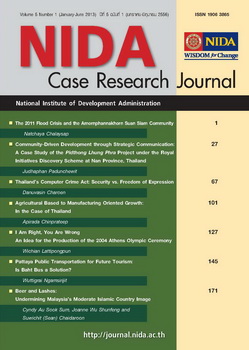The 2011 Flood Crisis and the Amornphannakhorn Suan Siam Community
Abstract
Heaving a weary sigh of relief, Warathep Boonyuen, chairperson of the Amornphannakorn Suan Siam community committee, could finally put the Great Flood of 2011 behind him. The past few months had been extremely stressful and tiring, as he—having been unexpectedly thrust into a community leadership position—had attempted to help the community cope with the challenges of draining the massive volume of water that had descended on the community two months earlier. The community had been all but unprepared to address the multiple challenges that accompanied the flood, which had been the biggest that Thailand had seen in nearly 50 years. Hence, the past two months had largely been one long series of ad hoc decisions and actions on the part of Warathep and a small group of his fellow Committee members, as they tried to stay on top of the situation and minimize the amount of damage to their large-sized community.
The authorities had not been able to predict either the amount of land that would eventually be flooded or the height of the water once the flood waters arrived. Not only had the amount of flood water flowing toward Bangkok been just an estimate, but flood waters from upper central provinces had reached the capital at different points in time. Additionally, the land area that flood water could occupy before flowing into the sea had been variable, depending on how well flood barriers held.
However, by the time flooding (that had begun in the upcountry provinces in September 2011) abated in mid-November 2011, the country had incurred economic losses totaling 1.44 million million baht (estimated by The World Bank), 815 deaths, and disruptions in the lives of 3.4 million affected people. Central Bangkok had escaped flooding, but outlying communities such as Amornphannakhorn Suan Siam had not, and thus suffered an array of problems brought by the floods – i.e., a major and prolonged disruption in the supply chain and transport, which had precipitated a severe shortage of food, medical supplies (e.g., anti-fungal medication) and clean drinking water; and, a heightening of the problems of daily work commutes (the government did not issue an order excusing government officials from work during the flood period). For weeks after the flood waters subsided, the Amornphannakhorn Suan Siam community continued to some, if not all, of these after-affects, as did communities in other areas of the country that had been impacted.Now that he had finished the distribution of the government-provided flood relief supplies that had belatedly arrived almost two months after the flood waters entered the Amornphannakhorn Suan Siam community, Warathep could at last stop to review and reflect at length on all that had happened. He felt that it was an important exercise to undertake in order to draw whatever lessons might be extracted for better handling of future community emergencies, floods or otherwise.





